This expedition begins with the ascent of Nevado San Francisco (6,017m) — a beautiful, non-technical peak ideal for acclimatization. From there, you decide how many and which other mountains to climb, based on how you’re feeling and how the expedition progresses.
You’ll have access to several iconic summits in the region, including the majestic Ojos del Salado (6,898m) — the highest active volcano on Earth — or more moderate options depending on your goals, experience, and conditions.
This flexible structure is only possible thanks to over a decade of guiding experience in the region. You’ll be supported by expert mountain guides every step of the way — including Maximo Kausch, the world record holder for most 6,000-meter peaks climbed in the Andes.
🔹 ‘Low’ 6000ers
(USD 450 per peak)
🔴 ‘Higher’ 6000ers
(USD 900 per peak)
Looking for inspiration? These are some of the most popular combos our clients choose:
These combos offer a balance of altitude progression, scenic variety, and challenge — perfect for those looking to make the most out of their 14-day expedition.
We recommend arriving during daylight hours to make the most of your day. Our team will pick you up at the airport, and we’ll have a welcome dinner with the full expedition group. Depending on your arrival time, you might visit a gear store; if not, we’ll handle that tomorrow.
Included: Airport transfer, hotel night & breakfast 🛏️
We’ll travel 210 km (approx. 4 hours) to a remote mountain hut by the beautiful Laguna Santa Rosa.
Included: Transport, breakfast, trail snack, dinner & shared mountain hut 🏞️
A warm-up trek to gain elevation and adapt to the altitude.
Included: Breakfast, trail snack, dinner & hut night 🛖
We drive approx. 120 km to our basecamp location by the surreal Laguna Verde, known for its 40°C thermal waters.
Included: Breakfast, transport, snack, dinner & tent night 🏕️
We hike to a 5,200m plateau on the slopes of Mulas Muertas, a beautiful viewpoint just behind our camp.
Included: Breakfast, trail snack, dinner & tents ⛺
Enjoy a full rest day and relax in the natural thermal pools.
Included: Breakfast, lunch, dinner & tents ♨️
We leave camp around 3:00 AM, drive 12 km by 4×4 to the trailhead, then climb San Francisco. Expect around 7 hours of hiking.
Included: Transport, breakfast, snack, dinner & tents 🏔️
A second rest day to help your body recover before potential higher ascents.
Included: Breakfast, lunch, dinner & tents 🌬️
We drive to Refugio Tejos (~5,800m), the highest shelter on Ojos. A light acclimatization walk up to 6,000m. Return to Laguna Verde for the night.
Included: Breakfast, transport, snack, dinner & tents 🚙
You’ll climb one or more mountains of your choice (depending on your plan and condition):
→ Ojos del Salado, Barrancas Blancas, Vicuñas, Tres Cruces Norte, etc.
Included: Breakfast, trail snack, dinner & tents 🏕️
We pack up camp and drive back to Copiapó.
Included: Breakfast, transport & hotel night 🏨
We’ll take you to the airport 2–3 hours before your flight.
Included: Hotel breakfast & airport transfer 🛫
Having the right mountaineering gear is essential for a successful expedition. Your equipment will be personally checked by one of our guides upon arrival at the hotel. Don’t worry if you’re missing something — you can easily rent or buy all necessary mountaineering equipment in Copiapo. Check our FAQ section for updated rental prices and details.
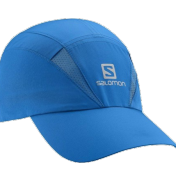
Hat or cap
For sun protection

Bandana
Buff or similar

Hat
Woollen hat or similar for cold days

Sunglasses (cat 3 or 4)
With side protection to fit your face

Sunscreen and lip balm
30 FPS or more

Batteries
AA or AAA batteries depending on your headtorch. Can be purchased in local store.

Headtorch
Working headtorch and spare batteries

Light down jacket

Summit Down Jacket
Heavy hooded down jacket for cold conditions

T-shirt
Synthetic fibre long or short sleeve t-shirt

Fleece jacket
Used alone or as part of a layer system for better performance
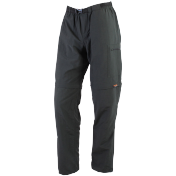
Trekking pants
Light trekking pants

Gaiters
For snow, sand or scree terrain
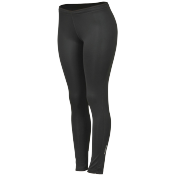
Base layer pants
For very cold days and summit push

Snowproof pants
Goretex or similar pants will be used for high wind or during snow conditions

Fleece Pants
Fleece, polartec or similar. To be used with other layers for very cold conditions
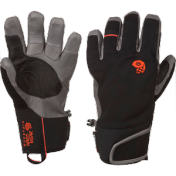
Waterproof gloves
A pair of good waterproof gloves for ice climbing with padded knuckles

Hand warmers
Chemical hand warmers for the summit push.

Mittens
Thick down mittens for summit push

Gloves
Fleece or polartec gloves for every day use

Sandals or crocs
Sandals or crocs for river crossing or hanging around camp

Trekking boots
Waterproof trekking boots, try wearing them before the expedition

Trekking socks
Good thick trekking socks

Thick expedition socks
For summit day
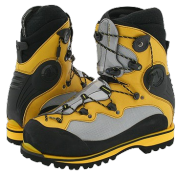
Double boots
A pair of double or double plastic boots such as Koflach Exped, Koflach Vertical, Asolo Ottomilla, Asolo AFS, Trezetta, Scarpa Vega, Scarpa Inferno, La Sportiva Baruntse, Olympus Mons, La Sportiva Spantik, Scarpa Phantom, La Sportiva G2.
Single layer boots such as La Sportiva Nepal XT, EVO, Batura or Boreal Latok, ARE NOT SUITABLE.

Crampons
Crampons with antibott system

Sunscreen
25fps or above, any brand

Carbo gels
These gels help out on recovery

Snacks
Salty snacks, sweets, etc. Any sort of tasty ready food as complement. On high altitude mountains we don’t normally worry about vitamins and proteins as these kinds of food are too hard to digest. You can buy all these in a local market.

Sleeping Bag
A good down sleeping

Rucksack
A decent rucksack with hip belt and rain cover

Altitude medicine
Our guides already have pretty much any drugs you might need during any trip. However, it would be great if you could have a spare tab of the most used drugs:
Ibuprofen (Advil)– This is an anti-inflammatory and works great for high altitude head aches
Loperamide (Imodium) – controls diarrea (not to be used in case of digestive infections. Ask our guides)

Personal Hygiene kit
Soap, tooth brus, come, etc

Sleeping mattress
We prefer taking 2 foam sleeping mattress because of sharp rocks. If you have an inflatable mattress you should also bring a foam mattress to protect the inflatable one against sharp rocks. Don’t forget bringing a repair kit if you have an inflatable mattress.

1 litre thermos
Metallic good quality 1 litre thermos for the summit push. You must have one. Please do not bring smaller ones.

Water bottle
Nalgene 1 litre bottles or similar are great for expeditions! We prefer to not use camelbacks as its hose pipe might freeze

Duffel Bag
Used to transport or store your equipment. In many cases, we transport your personal gear on animals and we don’t want your equipment to get wet or have mule smell…

Trekking poles
Gives you more stability during walk and summit push.
You can bring cash, make a bank transfer (we have Starlink internet), or arrange to pay after the expedition.
You can first climb Nevado San Francisco (6,017m), then decide based on how you feel. If you’re doing well, you can choose to continue and pay the difference on the spot.
We stay at Cumbres de Atacama, a spacious and comfortable hotel in the city center.
Yes. The hotel has a secure storage area. We’ve partnered with them for six years with no incidents.
We use only Refugio Laguna Santa Rosa (3,700m), where we spend two nights. Other huts are no longer used due to poor maintenance. We sleep 9 to 10 nights in tents.
Yes. All tents and hotel rooms are shared. Private accommodation is available at extra cost.
Yes. At Refugio Santa Rosa, there are three bathrooms. At Laguna Verde, we use toilet tents for solids and open latrines for liquids.
No. You’ll need to connect via Santiago. You can book a single ticket with a stopover or two separate flights (Europe > Santiago, Santiago > Copiapó). LATAM and Sky Airlines are the most common carriers.
Yes, all essential gear can be rented in Copiapó. Please let us know in advance. 2024 rental prices are: Thermal sleeping pad ($35), Down jacket ($115), La Sportiva double boots ($130), Down mittens ($50), Crampons ($50), Climbing helmet ($40), Ice axe ($50), Sleeping bag rated -5ºC to -10ºC ($90).
Yes. There are exchange offices that accept USD, Euros, and British pounds. The best rates are typically for US dollars.
Yes! We have solar panels and a generator at basecamp so you can charge your phone, camera, GPS, or other electronics.
Yes. You must have previous trekking experience — even for non-technical 6,000ers.
At Laguna Santa Rosa, there are no power outlets. However, we bring a solar panel system. Bring USB-compatible devices for easier charging.
Yes, but we recommend exchanging currency in Santiago, where rates are better.
Almost none. All gear is transported by 4×4 vehicles. We haven’t used high-altitude huts for sleeping in 4 years — only for rest stops.
Fly into Copiapó (CPO). We recommend arriving on Day 1 and departing on Day 14 of the itinerary.
Once we leave Copiapó, there is no cell signal. But we have Starlink internet, which allows connection throughout the expedition.
Yes, but the permit (DIFROL) is free and fully handled by the expedition leader.
All guides are trained in rescue procedures and have extensive high-altitude experience. We use 4×4 vehicles for evacuation, which can take up to 5 hours to reach a hospital.
Good cardio fitness is essential. We recommend regular running, swimming, or cycling in the months leading up to the trip.
You’ll need a sleeping bag rated for at least -10°C (14°F) comfort temperature.
The best option is to fly first to Santiago, Chile (usually via LATAM), and then take a connecting flight with Sky Airlines to Copiapó. This second flight can often be inexpensive. Alternatively, consider searching for direct flights from your home country to Copiapó, as LATAM sometimes offers cheaper connections.
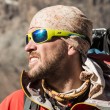
Language skills:
| English - native speaker |
| Spanish - native speaker |
| Portuguese - native speaker |
Maximo Kausch is one of the most accomplished and experienced high-altitude mountaineers in the world. Born in Argentina, raised in Brazil, and educated in the UK, he has been climbing for over 25 years and guiding professionally since the age of 23. He has led more than 118 expeditions, many to extreme altitude regions across the Andes, Himalayas, and beyond.
Recognized by Guinness World Records, Maximo holds the record for the most 6,000-meter peaks climbed—90 in the Andes alone—and has summited over 260 peaks above 5,500 meters. He’s participated in at least 11 expeditions to 8,000-meter peaks, including the formidable K2 in Pakistan.
In 2012, Max launched the Andes 6K+ Project, aiming to climb all 104 Andean peaks over 6,000 meters. To date, he has completed 85% of the challenge, including a solo season where he climbed 30 of these peaks alone—an unprecedented feat in South American mountaineering.
Beyond guiding, Max researches high-altitude medicine, teaches courses for physicians, and contributes to the classification and naming of Andean peaks. Known for his calm approach and meticulous planning, he emphasizes safety and acclimatization in every expedition.
Founder of Andes Specialists, Max shares his passion with climbers from all backgrounds. He’s visited over 30 countries, always seeking out remote and challenging mountains. Despite the records, Max remains focused on learning and sharing his love for the mountains with humility and dedication.
More about Maximo Kausch
World Record on 6000 metre peaks

Language skills:
| English - Good command |
| Spanish - native speaker |
| Portuguese - Good command |
Jorge Spur was born in Trelew, a city in the province of Chubut, in Argentine Patagonia, near the sea. At the age of 12, his family moved to Epuyen, a small town nestled in the mountains of Northern Patagonia. It was in this environment that Jorge began to explore and climb mountains from an early age. At 15, a physical education teacher introduced him to the fundamentals of hiking through the forests and mountains of the region.
He earned his Trekking Guide certification in 2011 and became a certified Mountain Guide in 2013 through the Provincial School of High Mountain and Trekking Guides in Mendoza. Over the course of his career, Jorge has climbed various mountains in Patagonia, the Central Andes, Bolivia, and Brazil.
Since 2015, Jorge has been working as a guide with Gente de Montanha, where he is also responsible for expedition logistics during the summer season in Argentina. During the rest of the year, he returns to Epuyen, where he dedicates himself to mountaineering, climbing, trekking, kayaking, and cycle touring—always planning his next adventure.
Throughout his career, Jorge has led more than 25 expeditions to Mount Aconcagua, completed over 42 expeditions to mountains above 6,000 meters, and helped more than 150 people achieve their mountaineering dreams. He has been guiding for Gente de Montanha for over 10 years.
Base Package: USD 2,550
Additional peaks starting at USD 450 each
2024 rental prices – confirm availability in advance: